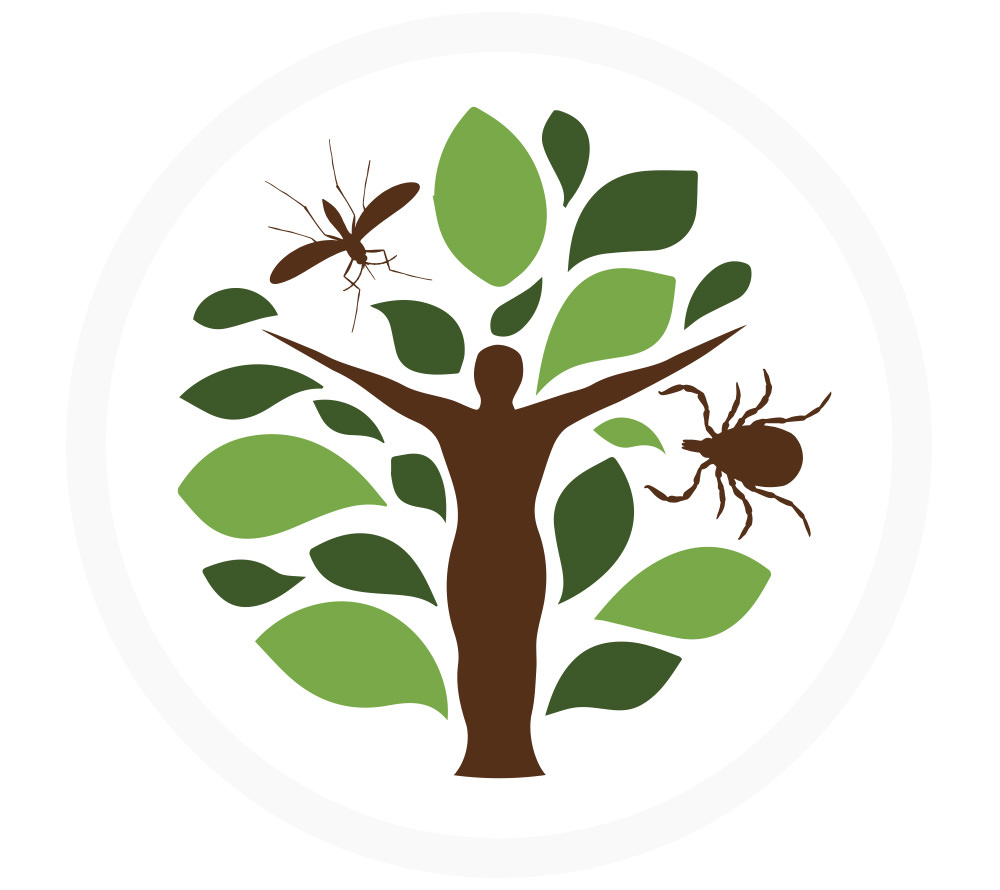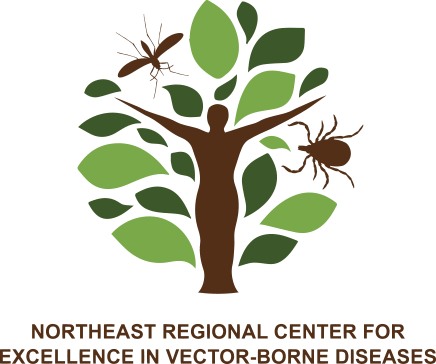Research Focus Area 1: Evaluation of Novel Trapping and Surveillance Methods for Vectors and Vector-Borne Diseases
Projects in this group focus on developing or significantly improving traps and field surveillance techniques to target the most important tick and mosquito disease vectors in the Northeast region. Our team of researchers are also testing field collections of ticks and mosquitoes to understand what pathogens they are carrying in targeted areas across the region.
PROJECT AREA: Enhanced surveillance of diurnal feeding and container-breeding mosquito species of concern in the Northeast region
Project Overview: Current operational trapping methodologies for mosquito vectors are not particularly effective for collecting diurnal (daytime) feeding and container-breeding species of concern, namely Aedes albopictus (Asian tiger mosquito), Aedes triseriatus (Eastern treehole mosquito), and Aedes japonicus (Asian rock pool mosquito). We are undersampling these key human-biting vectors.
Work in this project area is focused on evaluating new and existing trap types, lures, and strategies for collecting these undersampled mosquito species at multiple life stages. The successful completion of this work will enhance the ability of regional public health partners and vector control agencies to conduct effective surveillance in areas with established Aedes spp. populations and along the geographic limits of these populations in the Northeast. Accurate surveillance data is an essential component to implement effective and responsive control measures and public health action.
This work will be done in collaboration with county and city mosquito control districts and health departments in New York and Connecticut, as well as citizen science engagement.
Learn about the Invasive Boundary Project
Lead Institutions: Connecticut Agricultural Experiment Station, Cornell University, Fordham University, New York State Department of Public Health
Project Investigators:
- Theodore Andreadis, PhD, Connecticut Agricultural Experiment Station
- Philip Armstrong, ScD, Connecticut Agricultural Experiment Station
- Bryon Backenson, MS, New York State Department of Health
- Cierra Briggs, Cornell University
- Gillian Eastwood, PhD, Virginia Tech
- Richard Falco, PhD, Louis Calder Center, Fordham University, New York State Department of Health
- Andrea Gloria-Soria, PhD, Connecticut Agricultural Experiment Station
- Laura Harrington, PhD, Cornell University
- Joseph McMillan, PhD, Connecticut Agricutural Experiment Station
- Nicholas Piedmonte, MS, Louis Calder Center, Fordham University, New York State Department of Health
- John Shepard, MS, Connecticut Agricultural Experiment Station
- Talya Shragai, PhD, Cornell University
Project-Related Publications:
- Eastwood G, Donnellycolt AK, Shepard JJ, Misencik MJ, Bedoukian R, Cole L, Armstrong PM, and Andreadis TG. 2020. Evaluation of novel trapping lures for monitoring exotic and native container-breeding Aedes spp. (Diptera: Culicidae) mosquitoes. Journal of Medical Entomology. 57(2):534–541. doi:10.1093/jme/tjz200
- Shragai T, Mader EM, Harrington LC. Egg identification guide for Aedes albopictus in the Northeast, USA. 2018. Technical report. Northeast Regional Center for Excellence in Vector-Borne Diseases. Available at: hdl.handle.net/1813/60750
Additional Resources:
- New York State Department of Health - Mosquitoes and Disease - weekly reports on Ae. albopictus surveillance findings during mosquito surveillance season
PROJECT AREA: Monitoring of Mosquito Vectors and Mosquito-Borne Pathogens
Project Overview: The goal of this project area is to conduct enhanced screening of Northeast mosquito populations for arboviruses, including West Nile virus, Eastern equine encephalitis, La Crosse encephalitis virus, and Jamestown Canyon virus. In conjunction with NEVBD projects targeting enhanced mosquito surveillance methods, we intend to screen mosquito pools for these and other arboviruses to assess risk of human infection, inform the public and health care providers of these risks, and guide public health response to disease threats. Additional work in this project area includes an evaluation of arboviral detection in multiple vector species using historical and current surveillance data.
Lead Institutions: Connecticut Agricultural Experiment Station, Cornell University, Fordham University, New York State Department of Health
Project Investigators:
- Theodore Andreadis, PhD, Connecticut Agricultural Experiment Station
- Philip Armstrong, ScD, Connecticut Agricultural Experiment Station
- Bryon Backenson, MS, New York State Department of Health
- Cierra Briggs, Cornell University
- Douglas Brackney, PhD, Connecticut Agricultural Experiment Station
- Alexander Ciota, PhD, Wadsworth Center Arbovirus Laboratory, New York State Department of Health
- Thomas Daniels, PhD, Fordham University
- Andrea Gloria-Soria, PhD, Connecticut Agricultural Experiment Station
- Laura Kramer, PhD, Wadsworth Center Arbovirus Laboratory, New York State Department of Health
- Laura Harrington, PhD, Cornell University
- Joseph McMillan, PhD, Connecticut Agricultural Experiment Station
- John Shepard, MS, Connecticut Agricultural Experiment Station
- Jennifer White, MPH, New York State Department of Health
Project-Related Publications:
- McMillan JR, Andreadis TG, Armstrong P. 2020. Patterns of mosquito and arbovirus community composition and ecological indexes of arboviral risk in the northeastern United States. PLOS Neglected Tropical Diseases. 14(2):e0008066. doi:10.1371/journal.pntd.0008066
- Oliver J, Lukacik G, Kokas J, Campbell SR, Kramer LD, Sherwood JA, Howard JJ. 2018. Twenty years of surveillance for Eastern equine encephalitis virus in mosquitoes in New York State from 1993 to 2012. Parasites & Vectors 11(362) doi:10.1186/s13071-018-2950-1
- Petruff TA, McMillan JR, Shepard JJ, Andreadis TG, Armstrong PM. 2020. Increased mosquito abundance and species richness in Connecticut, United States 2001-2019. Sci Rep 10, 19287. doi:10.1038/s41598-020-76231-x
Additional Resources:
- State of Connecticut Mosquito Trapping and Arbovirus Testing Program - weekly reports on arbovirus surveillance during mosquito trapping season
- New York State Department of Health - Mosquitoes and Disease - weekly reports on arbovirus surveillance during the mosquito trapping season
PROJECT AREA: Monitoring of Tick Vectors and Tickborne Pathogens Populations
Project Overview: There is an increasing concern about the growing health threat from tick-borne diseases in and around the urban environment. Green spaces within urban centers provide suitable habitat for ticks infected with various tick-borne pathogens, and specifically the bacteria causing Lyme disease (Borrelia burgdorferi). The majority of tick-borne disease studies have been conducted in suburban and natural areas. Additionally, a warming climate and changes in land use patterns are affecting the distribution and abundance of multiple tick species across the Northeast region.
Work in this project area is focused on conducting tick surveillance in urban settings, and evaluating multiple surveillance approaches to monitor current tick population distributions and spread across the Northeast. This information will be essential to implementing effective and responsive control measures, and is pivotal to informing public health responses to emerging tick-borne disease threats in our communities.
Information collected through this work on tick species abundance, distribution, and infection will be shared with state and local health departments on an ongoing basis.
Lead Institutions: Columbia University, Connecticut Agricultural Experiment Station, Cornell University, Fordham University, New York State Department of Health
Project Investigators:
- Bryon Backenson, MS, New York State Department of Health
- Thomas Daniels, PhD, Louis Calder Center, Fordham University
- Maria Diuk-Wasser, PhD, Columbia University
- Richard Falco, PhD, Louis Calder Center, Fordham University, New York State Department of Health
- Maria del Pilar Fernandez, PhD, Columbia University
- Laura Harrington, PhD, Cornell University
- Erin Hassett, MS, Cornell University
- Laura Kramer, PhD, New York State Department of Health, Wadsworth Center Arbovirus Laboratory
- Eliza Little, PhD, Connecticut Agricultural Experiment Station
- Goudarz Molaei, PhD, Connecticut Agricultural Experiment Station
- Nicholas Piedmonte, MS, Louis Calder Center, Fordham University, New York State Department of Health
- Melissa Prusinski, New York State Department of Health
- Kirby Stafford III, PhD, Connecticut Agricultural Experiment Station
- Kate Thornburg, Cornell University
- Danielle Tufts, PhD, Columbia University
- Meredith VanAcker, Columbia University
- Jennifer White, MPH, New York State Department of Health
- Scott Williams, PhD, Connecticut Agricultural Experiment Station
Project-Related Publications:
- Little EAH, Molaei G. 2020. Passive tick surveillance: exploring spatiotemporal associations of Borrelia burgdorferi (Spirochaetales: Spirochaetaceae), Babesia microti (Piroplasmida:Babesiidae), and Anaplasma phagocytophilum (Rickettsiales: Anaplasmataceae) infection in Ixodes scapularis (Acari: Ixodidae). Vector-Borne and Zoonotic Diseases, 20(3):177-186. doi:10.1089/vbz.2019.2509
- Mader EM, Ganser C, Geiger A, Harrington LC, Foley J, Smith R, Mateus-Pinilla N, Teel P, Eisen R. 2020. A survey of tick surveillance and control practices in the United States. J Med Entomol. Epub ahead of print 17 June 2020. doi:10.1093/jme/tjaa094
- Molaei G, Karpathy SE, Andreadis TG. 2019. First report of the introduction of an exotic tick, Amblyomma coelebs (Acari: Ixodidae) feeding on a human traveler returning to the U.S. from Central America. Journal of Parasitology 105(4):571-575. doi:10.1645/19-74
- Molaei G, Mertins JW, and Stafford III KC. 2020. Enduring challenge of invasive ticks: Introduction of Amblyomma oblongoguttatum (Acari: Ixodidae) into the United States on a human traveler returning from Central America. Journal of Parasitology. 106(5):670-674. doi:10.1645/20-85
- Pokutnaya, D., G. Molaei, D. Weinberger, C. R. Vossbrinck, and A. J. Diaz. 2020. Prevalence of infection and co-infection and presence of Rickettsial endosymbionts in Ixodes scapularis (Acari: Ixodidae) in Connecticut, USA. J. Parasitol. 106(1):30-37. doi:10.1645/19-116
- Stafford III KC, Molaei G, Little EAH, Paddock CD, Karpathy SE, Labonte AM. 2018. Distribution and establishment of the lone star tick, Amblyomma americanum (L.) (Acari: Ixodidae) in Connecticut and implications for range expansion and public health. Journal of Medical Entomology 55(6):1561-68. doi:10.1093/jme/tjy115
- Yuan Q, Llanos-Soto SG, Gangloff-Kaufmann JG, Lampman JM, Frye MJ, Benedict MC, Tallmadge RL, Mitchell PK, et al. 2020. Active surveillance of pathogens from ticks collected in New York State suburban parks and schoolyards. Zoonoses and Public Health. 67(6):684-696. doi:10.1111/zph.12749

